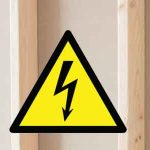Stud walls are extremely common in modern properties, they are convenient and easy to install. Offering an alternative to brick, or block partition walls.
The wall itself is constructed of several parts. These include, the base and top plate, the upright timbers, also known as the studs, and finally the noggins to tie everything together.
The spacing of the studs in your wall can often be confusing, reading peoples opinion online you will often see several different numbers thrown around. In my experience the most common are:
- 400mm centres (most stud wall spacing in the UK)
- 450mm centres
- 600mm centres
In my career as a joiner, the most common spacing I have worked with, is 400mm centres. This offers the most stability when fixing plasterboard and is the correct size to ensure boards land on the studs for fixing.
Some people would argue, that if you are using wider 4X2 timbers, 600mm centres are adequate. However, in most cases I would still opt for 400mm, as wider gaps will allow the attached plasterboard to flex more. The frame may be wider and slightly more robust, but the real issue is the rigidity of the attached board.
450mm centres will generally be used if you are fitting different sized boards such as 900mm x 1200mm. You may choose this size if access with larger boards is more difficult. Or they may be used, if you are installing them alone and would struggle lifting 1200mm x 2400mm boards on your own.
Marking out your stud wall spacing
When marking out the centres for your stud wall, it is best practice to mark your base and top plate at the same time. You can do this by laying them next to each other and marking where the studs will go. To do this you will need a square, a pencil, and a tape measure.
Firstly, you should make sure the timbers are the correct length. The length of each timber may differ slightly if there is a slight discrepancy in width at floor and ceiling height. However, they should be very similar, if not the exact same length.
Once you have your base and top plate, lay each piece of timber on edge, alongside one another. Next, starting at one end, make sure the ends of each timber are flush. Here you will mark a line across both pieces to mark out the first stud placement. If you are using 3×2 this will be roughly 47mm.
Between the end of the timber and the line at 47mm, draw a cross on each timber to highlight where the stud is going (this will make sure you don’t fix to the wrong side of the line).
To mark the position for the second stud, you will need to remember, you are measuring from the wall not the first stud’s centre. Therefore, the measurement will be 400mm from the wall edge to the centre of your second stud.
The best way to do this, is subtract half the width of a stud and measure from the end. This will mean the edge of the timber will land at roughly 376mm from the end of the timber. Again, draw a line across both timbers with your pencil and square and draw a cross to show where the stud will be fixed.
Following this, you can mark a line with a cross to the side every 400mm. See the image below for a visual representation of how this should look:

Marking out door openings
One other thing you may need to consider, is marking out for any door openings. Common door sizes can range anywhere from 457mm to 926 mm. So you need to figure out the door size you will be fitting.
You will also need to account for the casing, as well as adequet space to fit the caisng and the door.
To learn more about door opening sizes in studwork click here
Building your stud wall
There are two main ways to build your stud wall.
- You can build it on the floor and stand it up once built, into the space it is being fitted. Personally, this is my favourite way to build stud walls, it makes the entire process extremely easy. Once the wall is stood in place, you can easily plumb it up, and get the exact position to fix it. However, it is dependent on space. You will need a decent amount of floor space to build your frame this way.
- The second way is to build your wall in situ. This is (in my opinion) slightly more difficult and slower. Essentially you will need to fix the base plate first and build the frame up from there. Sometimes this can be easier with two people. Mainly because all the timber is lose and you need to make sure everything is being fixed plumb from the base to the top plate.
There is no right or wrong way. For many tradesmen, it will come down to personal preference and how they learnt to do the job.
There is also the issue of space. My personal bias would be to build the frame and then stand it up in place. However, if space doesn’t allow this, I would instead build the frame in situ.
Whichever way you decide, marking your 400mm centres on the top and bottom plate will help you to build the frame much easier, as you will have accurate lines to fix too.
Once your wall is built and the studwork is fixed in place, you will need to add noggins and then you can proceed to insulate, and board the wall.
To find out the best size fixings to use in your studwork click here
Conclusion
So, should stud wall spacing be 400 or 600 centres, which is better? Based on this article I think its clear that 400mm is the best option, in almost all scenarios.
There are several different spacing methods for internal studwork. However, 400mm is by far the most common. It offers a decent level of stability, and it is spaced correctly for fitting internal and external materials, such as insulation and plasterboards.




